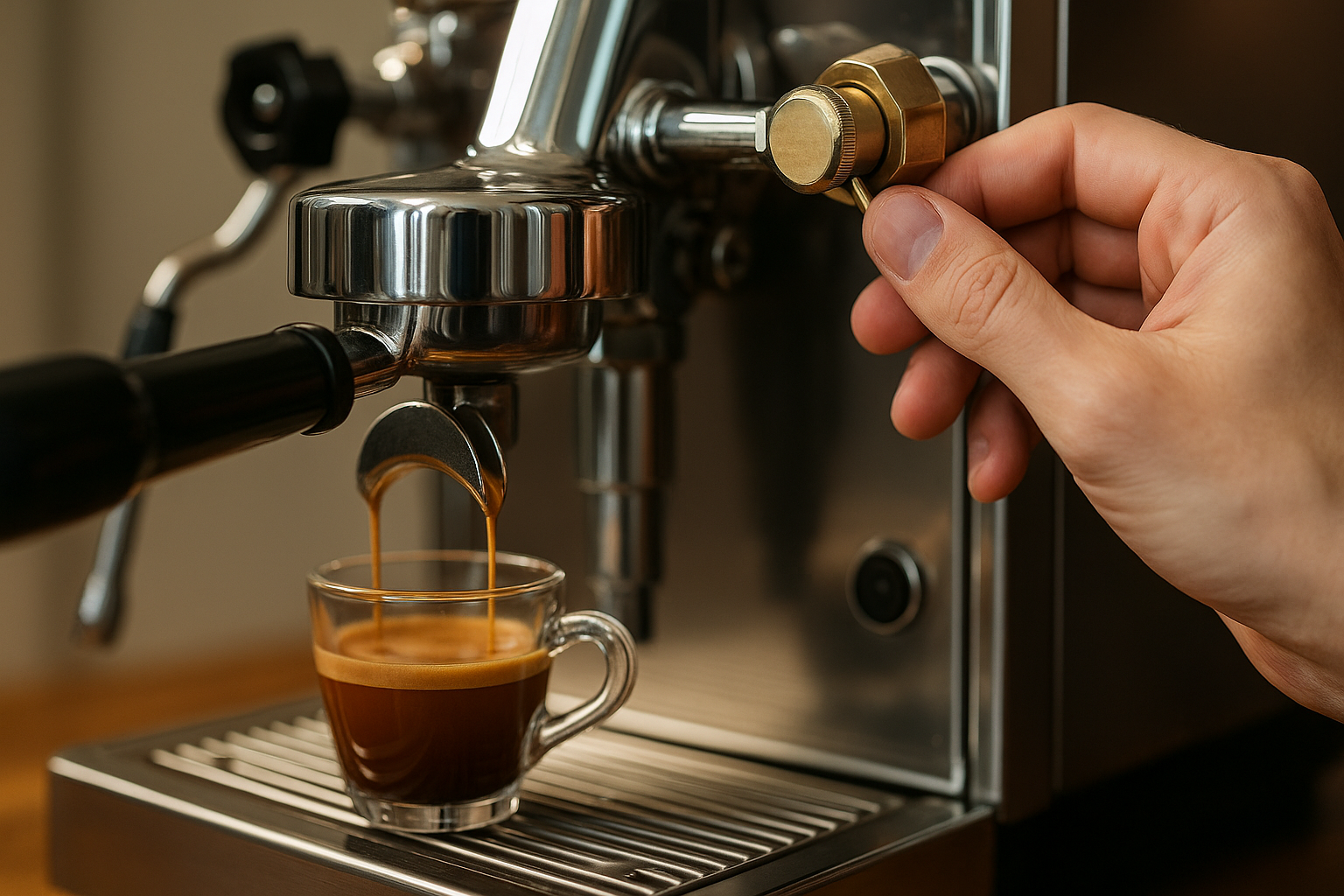As coffee technology evolves, more baristas are turning to flow control systems to elevate their espresso quality.
While traditional machines operate at a fixed pressure, flow control allows for precise manipulation of water flow through the coffee puck.
This seemingly small detail can dramatically change extraction results, flavor profiles, and consistency.
In this article, we’ll explore:
- What flow control is and how it differs from pressure control
- The science behind flow rate and flavor development
- Benefits of using flow control in espresso
- How different profiles impact taste
- How to use flow control step-by-step
- Tools and machines that support it
- Common mistakes and best practices
Let’s begin with the fundamentals.
What Is Flow Control in Espresso?
Flow control refers to the ability to manually or electronically regulate the rate at which water passes through the coffee puck during brewing.
While pressure profiling manages the force applied, flow control focuses on how much water enters the puck and how quickly.
Flow rate is usually measured in milliliters per second (ml/s). Controlling this flow influences the total contact time between water and coffee grounds, which directly impacts extraction.
Flow Control vs. Pressure Profiling
- Flow Control = Regulates how fast water flows
- Pressure Profiling = Regulates how hard water is pushed
While both techniques can shape the brew, they work differently. Flow control gives a gentler and more gradual approach to flavor extraction. Many machines now combine both technologies for superior customization.
Why Flow Rate Matters
Every espresso shot is a balance of several variables:
- Grind size
- Dose
- Water temperature
- Brew ratio
- Contact time
- Flow rate
Flow rate affects:
- Turbulence in the puck
- Channeling risk
- Time water interacts with coffee
- Uniformity of saturation
A slower flow rate can reduce channeling, increase clarity, and extract delicate flavors from light roasts. A faster flow rate can highlight body and intensity, especially in darker roasts.
The Science Behind Flow Control
Water flows through coffee grounds following paths of least resistance. This means if the puck is unevenly distributed, water rushes through one area more than others, leading to under- and over-extraction in the same shot.
By regulating flow:
- You control how quickly the puck saturates
- You encourage even distribution of water pressure
- You allow flavor compounds to dissolve at optimal times
This leads to more even extraction and better-tasting espresso.
Phases of Espresso Using Flow Control
A flow-controlled shot can be broken into stages, each with a different purpose.
1. Pre-Infusion (1–2 ml/s)
Water flows very slowly at the beginning to saturate the puck without pressure buildup. This stage:
- Allows the coffee bed to expand evenly
- Minimizes channeling
- Gently initiates extraction
2. Ramp-Up (3–4 ml/s)
Once the puck is saturated, flow is increased slightly to begin full extraction. You extract acids and sugars first—key for brightness and sweetness.
3. Steady Extraction (5–6 ml/s)
Flow is held steady to draw oils, deeper flavors, and body. This is the most flavor-rich phase.
4. Tapering Off (2–3 ml/s)
Flow is reduced again at the end to avoid over-extracting bitter compounds. It’s a soft landing for the shot.
Benefits of Flow Control
- Improved Shot Consistency
Controlling flow minimizes the risk of poor shots due to grind inconsistencies or puck prep errors. - Better Extraction for Light Roasts
Lightly roasted beans are harder to extract. Slowing the flow helps release their complex acids and aromatics. - Richer Flavor Development
Flow profiles help extract a fuller spectrum of flavors. You get more nuance, more texture, and better balance. - Adjustability for Different Coffees
Each coffee is unique. Flow control lets you adapt to:
- Origin
- Process method
- Roast level
- Reduced Waste
You’ll throw away fewer shots during dialing in, which saves beans and time.
Manual vs. Automatic Flow Control
Manual Flow Control
Most common on prosumer espresso machines. You control flow using:
- A needle valve
- A rotary knob
- A paddle lever
It gives tactile feedback and full control—but requires practice and attention.
Automatic Flow Control
Used in high-end machines, often paired with presets. Flow curves are programmed into the machine and applied consistently shot after shot.
It’s ideal for commercial cafés or baristas looking to streamline workflow.
How to Use Flow Control: Step-by-Step
- Prepare Your Coffee
Use a consistent grind and 18–20 grams of fresh coffee. Tamp evenly. - Set Flow to Low (1–2 ml/s)
Begin pre-infusion for 8–10 seconds. Watch for coffee swelling and darkening—this shows full saturation. - Increase Flow (3–4 ml/s)
Ramp up over 5–8 seconds. Look for the first drops of espresso and bloom in the basket. - Hold Steady Flow (5–6 ml/s)
Maintain this for most of the shot. Observe the color and texture of espresso—crema should be even and golden. - Ramp Down (2–3 ml/s)
Ease off during the final 5 seconds. This smooth finish avoids harsh notes. - Stop at Target Yield
Aim for a 1:2 ratio—e.g., 18 g in, 36 g out in 30–35 seconds.
Different Flow Profiles and Their Effects
| Profile Type | Description | Ideal For |
|---|---|---|
| Flat Profile | Constant flow from start to finish | Everyday espresso blends |
| Gentle Start | Low to high flow curve | Light roasts, high acidity |
| Stepped Profile | Alternating flow levels in stages | Complex single origins |
| Reverse Taper | Fast start, slow finish | Minimizing bitterness |
| Long Pre-Infusion | Very low flow for 15+ seconds | Delicate floral coffees |
Experimenting with different profiles reveals how dramatically flow affects the taste and mouthfeel of your shots.
Machines That Offer Flow Control
Many high-end espresso machines now offer built-in flow control. Some can even be retrofitted with flow kits. Common setups include:
- Rotary valve with paddle
- Needle valve with numeric scale
- Electronic actuator with display
These are typically found in machines with E61 groupheads or custom setups.
Troubleshooting Common Issues
Shot Too Fast
- Flow may be too high at start
- Reduce ramp-up time
- Check for uneven tamp or grind too coarse
Shot Too Sour
- Extraction may be incomplete
- Try slower pre-infusion or increase flow mid-shot
Shot Too Bitter
- Flow may be too aggressive at the end
- Taper off the flow earlier
Inconsistent Crema
- Flow is not evenly saturating puck
- Adjust pre-infusion duration or improve distribution
Tips for Dialing in with Flow Control
- Use Visual Cues
Watch the color and behavior of the espresso stream. It tells you how the extraction is progressing. - Change One Variable at a Time
Alter flow profile, grind, or temperature independently to track their effect. - Take Notes
Record flow rates, timing, taste notes, and yield for each shot. - Keep It Simple at First
Start with two-stage profiles. Once confident, explore more complex patterns. - Taste Before Adjusting
Don’t chase numbers. Always let taste guide your final profile.
Training Your Palate with Flow Control
Using flow control helps develop your sensory skills. By slowing down extraction, you isolate specific flavor moments:
- Acidity in early phase
- Sweetness in middle
- Bitterness in final phase
This makes it easier to identify what’s missing or overpowering. Over time, you’ll intuitively match flow profiles to bean types and roasts.
Using Flow Control Beyond Espresso
Flow profiling isn’t limited to espresso. Similar concepts apply in:
- Pour-over (changing kettle flow rate)
- AeroPress (controlled plunging)
- Siphon brewing (managing turbulence)
Understanding flow in espresso sharpens your overall brewing intuition.
Final Thoughts
Flow control is not just a feature—it’s a method of expression. It gives baristas more control over their craft, helps unlock a wider range of flavors, and makes each espresso shot more intentional.
Whether you’re dialing in a single origin, perfecting a house blend, or exploring the limits of light roast complexity, flow control is a powerful tool in your espresso journey.
It may take practice to master, but once you do, every shot becomes a personalized flavor experience.

Artur is a coffee enthusiast and content creator passionate about barista techniques and coffee culture. With a sharp eye for detail and a love for learning, he shares practical tips, brewing guides, and gear insights to help readers elevate their coffee experience — from home brewers to aspiring professionals.
